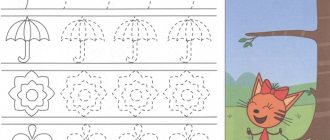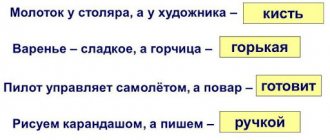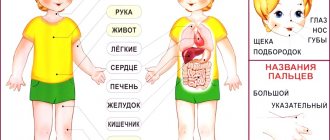An important indicator of the intelligence of a preschooler is the development of speech at the age of 5-6 years. At this age, the child knows 3000-4000 words and pronounces most of the sounds correctly. Children are able to construct detailed phrases and give detailed descriptions. To improve pronunciation and develop vocabulary, didactic games, finger and articulation gymnastics are used.
The speech development of a 4-5 year old child is very important.
Typical speech disorders in children 5-6 years old
Most older preschoolers have difficulties with:
- mastering sonorous and hissing sounds;
- sound analysis of words;
- development of narrative speech;
- writing a story and descriptions.
Of course, such problems can be minor, only slightly different from the age norm, or serious, up to and including general speech underdevelopment (GSD). It is necessary to contact a speech therapist in any case, but the supportive work of parents at home is also very important.
It is worth noting that regular speech therapy exercises and classes for children 5-6 years old are useful for every child at home, because they help to master literacy faster.
Norms of speech development
By the age of five, the range of development of coherent speech is quite wide. It can begin with the monotonous and monosyllabic speech of a preschooler whose parents did not study with him, and end with the ability to compose fairy tales and speak on a par with adults.
Still, there are criteria based on which those very norms can be determined.
- Almost complete absence of grammatical errors.
- Developed articulation system and correct pronunciation.
- Correct stress in words, except for unfamiliar ones.
- Detailed answers to questions.
- The ability to compose a story from pictures, figure out the end of the story on your own, compose a tale, retell a story you have read.
- The ability to give a broad description of objects, recalling many of its qualities.
- Ability to classify words into groups. For example, strawberries, raspberries, currants, and cherries are berries.
- Sentences use all parts of speech, including participial and participial phrases.
- Ability to control the pace and volume of speech.
Rules for speech therapy classes at home
The success of home lessons depends not only on the availability of the necessary aids and a work plan agreed upon with the speech therapist. The organization of classes itself is very important. Here are a few simple rules that will help you achieve excellent results:
- All speech therapy exercises for children should be carried out regularly, but a little at a time. You shouldn’t try to do articulation gymnastics, play speech games, or fill out a workbook right away. It is better to devote a few minutes to each type of exercise, rather than having a whole “speech therapy day.”
- Do not force them to complete tasks under pressure; educational activities for children should resemble a game. Come up with a simple plot (for example, a journey into the universe of sounds), prepare small prizes (stickers, paper stars), and arrange physical exercises.
- Praise and support the little student if he makes even the slightest progress. Focus on achievements, even small ones, gradually progress will become more and more obvious.
- Find good workbooks for home practice. They should not only be professional in content, but also bright, colorful, and exciting. It is ideal if the tasks have interactive elements (the opportunity to add something, draw something). Such material makes it possible to interest a preschooler and clearly shows him the “path traveled” and success.
- Don't expect instant results, be patient and gentle perseverance. The process of setting, consolidating, and differentiating sounds is complex; it takes months even for experienced speech therapists. Follow the plan and the results will gradually appear.
We teach in the game
After analyzing the above norms, parents can understand which areas of their child’s speech need to be developed first: those with which there are problems. To correct each individual area, you can select appropriate games for speech development. First of all, to expand your vocabulary. Here are some examples of such games.
- The adult names the object, and the child must put this word in the plural (wall - walls). In the course of such a game, you can also touch on polysemy (for example, a child, a chair or a seat can have a back, and a mug in the plural, only with a different emphasis - these are both geometric figures and sections for creative activities). At the same time, the child’s attention is promptly focused on the fact that not all words “multiply” equally (lion - lions, mouth - mouths). This develops the skill of using the plural and expands your vocabulary.
- You can introduce your child to antonyms by offering to select opposite meanings for words (soft - hard, clean - dirty). At the same time, let him select words with new meanings (white snow - black night), and then replace them with pronouns (he is white, she is black). This way the preschooler will practice agreeing words and using pronouns.
- After reading a story or poem, you can invite your child to come up with his own ending. It also develops thinking, imagination and coherent speech.
- Playing with a ball allows you to develop various skills: enrich your vocabulary, master synonyms, antonyms, recognize objects by description, form new forms of words. For example, a child is thrown a ball, naming the object, and he returns the ball, calling the object affectionately. Or in response to a word it selects the opposite meaning. Or names an object, having heard its signs, names the color of the specified object. Parents' imagination can suggest other options for such games.
- Animate and inanimate objects. The concept of them can be easily reinforced by playing with cards: the child must put animate objects in one group, inanimate ones in another, helping himself with questions: “This is a pear. She is alive? No. This is a cow. She is alive? Yes".
- Using a similar exercise, you can introduce your baby to relative adjectives. One group of cards will contain objects, the other will contain the materials from which they are made. The child’s task is to correlate the two pictures, saying: the ball is made of rubber. It's rubber. The pencil is made of wood. It is wooden.
In order for a preschooler’s speech to become more expressive, offer him such a game (several children or a family should play). The child, on the instructions of the adult, must demonstrate to the other players different shades of a person’s mood (fun, surprise, sadness, anger, fatigue, despondency). In this case, the baby can use appropriate intonation, facial expressions, interjections (oh-oh, wow, wow, eh, ah, ah-ah). The rest of the players guess what exactly was shown.
Speech therapy exercises for practicing at home
All speech therapy exercises can be divided into three large blocks, each of which needs to be given attention and carried out regularly:
Development of phonemic hearing
The ability to distinguish sounds by ear seems natural, but if you ask your preschooler to spell a word, you will see gaps.
For children 5-6 years old, there are a large number of special games and exercises that help develop phonemic hearing. These include:
- selection of words starting or ending with a given sound;
- counting sounds in a word, determining the syllable structure;
- drawing up a sound diagram of a word;
- inventing rhymes and short poems;
- pronouncing speeches and tongue twisters.
Thoughtful speech therapy classes for children 5-6 years old make it possible to make all the sounds of their native language obedient and easy.
Finger gymnastics
Fine motor skills of the hands help speech activity, so older preschoolers must do it without fail.
Of course, for children 5-6 years old, the exercises should be complex, with a script, in verse. It is useful to select sets of exercises for both hands at the same time, synchronous. Don't forget to use "helpers":
- small massagers (rubber balls, rollers, cones);
- scissors for cutting;
- plasticine;
- origami paper.
Also remember that all types of needlework, construction, and any creativity are great ways to improve fine motor skills outside of individual lessons.
Articulation gymnastics
Special language exercises must be performed every day if there are any problems with pronunciation. For home exercises, it is best to choose a set of exercises with a poetic description and pictures.
Do a tongue warm-up every day, always in front of a mirror (this allows the baby to observe the process himself, assessing its success). If you have problems with one or two sounds, then articulatory gymnastics should be selected for them. These can be found in thematic workbooks on speech therapy.
What will we develop?
For children 4–5 years old, several aspects of speech development are important, which directly depend on the level of their general development and condition, as well as the speech skills they have achieved.
- Active dictionary.
Now, in addition to nouns and verbs, the speech of preschoolers is distinguished by the presence of adverbs with signs of time and space (soon, now, about, around). The concept of stages of generalization (mouse - rodent - animal) appears. Children know animals, their babies, parts of objects (a car wheel, a cabinet shelf, a chair leg).
Expanding your vocabulary at this age is the main rule for mastering coherent speech.
- The grammatical structure of speech.
Children of this age are actively engaged in word formation. They begin to use suffixes that designate a person by his profession. Now the child forms word forms in a similar pattern, using the same grammatical features. Sometimes it may turn out incorrectly: it hurts - more painful, louder - louder. In the speech of children, there are fewer and fewer errors associated with the inflection of nouns and verbs. But if a mistake is made, after a hint from an adult, the child quickly learns the correct option: floor - floors, lake - “lakes” - lakes.
Mastering the grammatical construction of sentences will help children speak correctly, avoiding speech errors.
- Coherent speech.
After 4 years, children develop contextual speech in addition to situational speech. Inconsistent presentation of events and retelling with the help of questions or prompts from adults are also possible. By the age of 5, without additional help, a child can compose a coherent retelling of several dozen sentences, and among them there are already complex and complex constructions. At this age, the internal, planning function of speech is formed - it becomes a means of planning and regulating the child’s internal behavior.
From this time on, the speech gradually turns into a full-fledged story. In addition, the child increasingly uses the communicative function of speech - uses it for a variety of communication with others. He can ask again, object, clarify, and answer questions with reason.
Mastering coherent speech is an important factor in the success of a child’s further education.
- Speech (phonemic) hearing.
Children of this age group distinguish sounds of different articulations (for example, [a] and [r]), and note pronunciation errors not only in those around them, but also in themselves. Change intonation and timbre of voice during expressive retelling. They can distinguish vowels from consonants, hard from soft, hissing from whistling. They are able not only to determine whether there is a specific sound in a word, but also where exactly it is located (at the beginning, middle, end of the word).
The development of phonemic awareness allows you to pronounce words correctly, and then reproduce them in writing just as correctly.
- Pronunciation.
Normally, by the end of the 5th year, all inaccuracies and difficulties in sound production should disappear in a preschooler. Perhaps the child will pronounce middle sounds between [s] and [sh], [z] and [z], if he has recently mastered them. Sometimes children at this age do not pronounce [r]. At 5 years old, this problem already requires correction by a speech therapist.
So, a five-year-old child should speak expressively, coherently, using a rich vocabulary and a variety of syntactic structures, with virtually no speech errors, pronouncing all sounds clearly. It is important to work on this by involving the child in various linguistic games.
Speech therapy tasks
Starting with the letter R
One of the most difficult sounds to master is R. Many preschoolers learn to roar loudly by the very end of kindergarten. If the production of the sound P is already behind you, then special exercises will help speed up its automation:
1. “Like a little motor”
We ask the child to pronounce the sound R in the word for a long time, drawlingly (like a motor growls).
2. “Where is R hiding?” (in pictures and words)
Offer to choose pictures with images of objects with a given sound or clap your hands if he hears such a word.
3. “How can you growl?”
Show your child pictures of objects that have the sound r in their names. Offer to read and color the picture.
4. “Sounding tracks”
Together with your child, come up with several chants made up of several syllables:
Ra-ra-ra - they ran away from the yard.
Ro-ro-ro - and they found a bucket.
Ru-ru-ru - we came up with a game.
5. “Substitute a syllable”
The adult offers the child words that end or begin with a syllable with P (ra, ro, ry), the child must choose the correct option and pronounce it correctly.
6. “Look and name”
An adult asks the child to read words with the letter r from the pictures. The word must be said as many times as there are stars next to each picture.
7. “Poems, tongue twisters, riddles”
Learn with your child several poems and riddles in which words with R appear.
The necessary tasks for speech development can be found in the Workbook for the sound R, compiled by Kostyuk A.V.
Download, print the tasks in pictures and study at home:
Speech therapy tasks for the letter P
Starting with the letter L
The hard sound L is also often difficult for children 5-6 years old. If the baby has already learned to pronounce it alone, in isolation, then it’s time to start working on automation in speech. The following exercises are suitable for this:
1. “Say it nicely”
Offer your child several images of words starting with L. Ask him to pronounce the words beautifully, emphasizing the desired sound with his voice.
2. “Toys for Larisa”
Ask your child to collect gifts for the Larisa doll. Tell her that she only likes things that begin with L. For this exercise, you need to select small objects or pictures in advance; all words should not begin only with L.
3. “One-many”
Invite your child to name words with L in the singular and plural. In the workbook for the sound L (author Kostyuk A.V.) there is a whole table with pictures for this exercise (lesson 20).
4. “Find the Sound”
Invite your child to draw up a diagram of the word and mark the place L on it. If it is still difficult for your child to independently determine the number of sounds, then first you can do several similar exercises from the workbook.
5. “Tongue twisters and nursery rhymes”
Use nursery rhymes, tongue twisters and poems with words that contain L.
Download and print tasks in pictures starting with the letter L:
Speech therapy tasks for the letter L
Age features
After 4 years, children are able to fluently use adverbs, adjectives, and prepositions, although the purity of pronunciation may still suffer due to difficulties with sonorants or sibilants (however, by the end of the fifth year, all sounds normally fall into place). A huge role in this belongs to parents, their ability to create a correct, active speech environment around the child and a favorable environment in the family.
The speech of children of primary preschool age is characterized by the following features:
- children can name the names, patronymics, surnames of all members of their family, and residential address;
- speak 3000–4000 words and actively use them;
- know how to navigate the time of day and the space around them;
- know the names and sequence of seasons;
- know all the basic geometric shapes, counting to five;
- use polite words;
- can identify their well-being and mood;
- know how to fully answer questions and ask them to the interlocutor;
- make a fairly detailed retelling, compose stories on a given topic, come up with the end of the designated story;
- can describe objects, identify an object only by description;
- build phrases of 6–8 words;
- use the imperative mood, plural;
- use synonyms and antonyms,
- use adjectives, adverbs, prepositions correctly;
- coordinate words in a sentence by gender, number, case;
- determine the distinctive features of objects;
- know different professions and their essence;
- can easily retell what they heard and saw;
- They know poems, tongue twisters, and funny nursery rhymes by heart.
At this age, do not put pressure on your child, forcing him to speak correctly and clearly - you will achieve the opposite effect. It is better to make comments in a soft form, affectionately, and friendly. Then the child will probably correct his mistakes very quickly.
When is it necessary to contact a speech therapist?
Each child is individual. Some people begin to speak early, but use two-word constructions for a long time; others begin to speak by the age of three, but in whole sentences and without any special problems with sound pronunciation. It all depends on the pace of the child’s overall development, his environment, past illnesses, etc.
But there are still certain signs that parents should not ignore.
Here are some of them:
- the child shows no interest in toys, all his games are stereotypical and monotonous;
- a child after two years of age cannot cope with simple tasks, such as putting a large bead on a rope or assembling a tower of cubes;
- does not understand simple instructions, such as fetching a ball;
- if the child does not speak, and there is a history of hereditary diseases, illnesses during pregnancy, or birth injuries.
Help from a speech therapist: when is it time?
We must sadly admit that modern means of communication, such as television and computers, have abruptly and thoroughly replaced communication from life. Reading books has been reduced to a minimum, but watching TV shows and cartoons takes almost half a day. Children communicate too little both with their parents and with each other. TV offers a wide range of everything interesting and exciting, which means there is no point in looking for other ways to obtain information.
READ ALSO: Quick reading lessons for children at home
This is where problems with sound pronunciation arise. They occur more and more often, and the problem sometimes gets worse quickly. Behind the TV and monitor, a parent may not notice that the child needs help, but it should be provided the sooner, the better. Any problem, in particular speech therapy, cannot be delayed, then the opportunity to correct what is wrong and deliver correct speech increases significantly.










